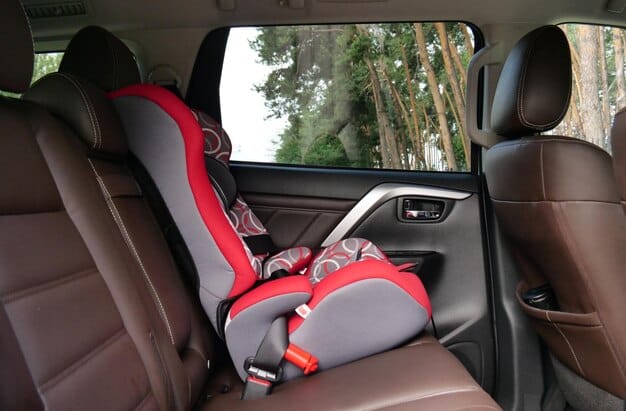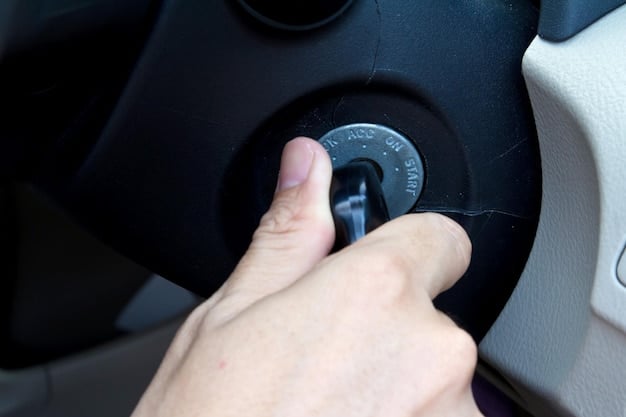Choosing the Right Car Seat: 2025 Safety Guide

Choosing the right car seat in 2025 involves understanding updated safety standards, various types like infant, convertible, and booster seats, and considering features like side-impact protection and ease of installation to ensure your child’s safety on the road.
Ensuring your child’s safety on the road is paramount, and choosing the right car seat: a 2025 guide to safety standards and features will empower you to make an informed decision. Selecting the appropriate car seat is not just a legal requirement; it’s a critical step in protecting your little one from potential harm in the event of a collision.
Understanding 2025 Car Seat Safety Standards
Navigating the world of car seat safety can be overwhelming, but understanding the latest standards is the first step in protecting your child. Car seat safety standards are constantly evolving to incorporate new research and technology, making car seats safer and more effective than ever before. In 2025, several key standards and regulations will shape the landscape of child passenger safety.
Updated Federal Motor Vehicle Safety Standards (FMVSS)
The FMVSS are a set of regulations established by the National Highway Traffic Safety Administration (NHTSA) in the United States. These standards outline the minimum performance requirements for car seats and other vehicle components to ensure safety. As of 2025, expect updates to FMVSS 213, which governs car seat performance, addressing side-impact protection and ease of use.
ISOFIX and LATCH Systems
ISOFIX (in Europe) and LATCH (Lower Anchors and Tethers for Children) are standardized attachment systems that make car seat installation easier and more secure. These systems reduce the risk of misuse by eliminating the need to use seat belts to secure the car seat. In 2025, LATCH systems continue to be a standard feature in most vehicles and car seats. Here are some benefits of using LATCH systems:
- Ease of Installation: LATCH systems simplify the installation process, reducing the likelihood of errors.
- Secure Attachment: These systems provide a more secure and stable connection between the car seat and the vehicle.
- Reduced Risk of Misuse: By using dedicated anchors, LATCH systems minimize the potential for incorrect seat belt routing.
Understanding and adhering to these safety standards ensures that your chosen car seat provides the best possible protection for your child.
Types of Car Seats Available in 2025
Choosing the right car seat also involves understanding the different types available and selecting one that matches your child’s age, weight, and developmental stage. Each type of car seat is designed to provide specific protection for children at different stages of growth.
Infant Car Seats
Infant car seats are designed for newborns and babies up to around 22-35 pounds, typically up to one year old. These seats are rear-facing only and feature a detachable carrier, making it easy to move your baby from the car to a stroller or indoors without disturbing them. Infant car seats are designed for optimal newborn safety. Key features include:
- Rear-Facing Position: Provides crucial support for the baby’s head, neck, and spine.
- Detachable Carrier: Allows easy transitions from car to stroller.
- Snug Harness System: Ensures a secure and comfortable fit for the baby.
Convertible Car Seats
Convertible car seats are designed to grow with your child, transitioning from a rear-facing seat for infants to a forward-facing seat for toddlers. These seats typically accommodate children from birth up to 40-65 pounds, making them a versatile and cost-effective option. This flexibility makes them a great long-term investment.

Booster Seats
Booster seats are designed for older children who have outgrown their forward-facing car seats but are still too small to use the vehicle’s seat belts alone. Booster seats raise the child to ensure that the seat belt fits properly across the shoulder and hips. There are many different types of booster seats:
- High-Back Boosters: Provide additional head and neck protection.
- Backless Boosters: Offer a more streamlined option for older children.
- Combination Seats: Can be used as a forward-facing car seat with a harness and then converted into a booster seat.
Understanding the features and benefits of each type of car seat ensures that you select the one that best meets your child’s needs and provides optimal safety.
Essential Features to Look for in a 2025 Car Seat
Beyond the type of car seat, several features can enhance safety and convenience. When choosing the right car seat, consider how these features align with your lifestyle and specific needs, keeping in mind that each feature contributes to the overall safety and convenience of the car seat.
Side-Impact Protection
Side-impact collisions are a significant risk, making side-impact protection a crucial feature in modern car seats. Look for car seats with enhanced side-impact protection, such as energy-absorbing foam and adjustable headrests that provide additional cushioning for the head and torso.
Adjustable Harness and Headrest
A properly fitted harness is essential for securing your child in the car seat. Look for car seats with an adjustable harness and headrest that can be easily adjusted as your child grows. This ensures that the harness straps are always at or slightly below the child’s shoulders in the rear-facing position and at or slightly above the shoulders in the forward-facing position.
An adjustable harness and headrest provide the most protection for the child. This feature can give you:
- Proper Fit: An adjustable harness ensures a snug fit as your child grows.
- Ease of Use: Makes it simple to adjust the fit without re-threading straps.
- Enhanced Safety: Correct positioning of the harness is crucial for optimal protection.
Ease of Installation
A car seat is only effective if it is installed correctly. Look for car seats with features that simplify installation, such as LATCH connectors, clear instructions, and built-in level indicators. Also, consider car seats with anti-rebound bars to help prevent injury during an accident.
Installation Tips for Car Seats in 2025
Proper installation is critical to ensure that your car seat provides optimal protection. Even the safest car seat can be ineffective if installed incorrectly. Here are some essential tips to help you install your car seat correctly.
Read the Manual
Always read the car seat’s instruction manual and your vehicle’s owner’s manual before installing the car seat. These manuals provide detailed instructions specific to your car seat and vehicle, including information on proper installation techniques and safety guidelines. Take the time to read and understand these instructions thoroughly for maximum safety.
Use LATCH or Seat Belt
Use either the LATCH system or the vehicle’s seat belt to secure the car seat. If using LATCH, make sure the connectors are securely attached to the lower anchors in your vehicle and tighten the straps properly. If using the seat belt, follow the instructions in the car seat manual to route the belt correctly and lock it in place. Make sure the car seat does not move more than one inch in any direction when tested at the belt path.

Check the Angle
Ensure that the car seat is at the correct angle for your child’s age and weight. Most car seats have built-in level indicators or angle adjusters to help you achieve the proper angle. For rear-facing car seats, the angle should be reclined to prevent the baby’s head from slumping forward and obstructing their airway.
Following these installation tips can make the process a little less stressful. They help to ensure your child’s safety. Getting your car seat installed correctly is key to your child’s well-being on the road. A correctly installed car seat will guarantee your child’s safety.
Common Mistakes to Avoid When Using Car Seats
Even with the best intentions, parents can make common mistakes that compromise their child’s safety. Here are some mistakes to avoid when choosing the right car seat in 2025, so that you’ll be well prepared.
Turning Forward- Facing Too Soon
One of the most common mistakes is turning a child forward-facing too soon. Children should remain rear-facing as long as possible, until they reach the maximum weight or height limit specified by the car seat manufacturer. Rear-facing is the safest position for young children, as it provides better support for their head, neck, and spine in a crash. Therefore, it is important to make sure you do not switch forward-facing early.
Loose Harness Straps
Loose harness straps are another common mistake that can reduce the effectiveness of the car seat. The harness straps should be snug enough that you cannot pinch any excess webbing at the child’s shoulder. A snug harness ensures that the child is properly restrained in the event of a collision.
Using Bulky Clothing
Bulky clothing, such as winter coats, can interfere with the fit of the harness straps, creating a gap between the child and the harness. In a crash, this gap can compress, allowing the child to be ejected from the seat. Dress your child in thin layers and place a blanket over them after they are buckled into the car seat. Making sure you use thin clothing will help the car seat protect them properly.
Car Seat Maintenance and Longevity
Proper maintenance and care are essential to ensure that your car seat remains safe and effective. Car seats have expiration dates, and regular inspections can help identify any potential issues. Maintenance is extremely important to the longevity of your car seat, so be sure that you’re up to the task.
Expiration Dates
Car seats have expiration dates, typically six to ten years from the date of manufacture. These dates are set because the plastic in car seats can degrade over time, becoming brittle and less able to withstand a crash. Check the car seat for its expiration date and replace it when it expires.
Regular Inspections
Inspect the car seat regularly for any signs of damage, such as cracks, tears, or broken parts. Check the harness straps, buckles, and LATCH connectors to ensure they are in good working condition. Replace any damaged parts immediately to maintain the car seat’s safety performance.
By following these maintenance and longevity tips, you can ensure that your car seat remains a safe and reliable protection for your child on the road for years to come. Taking the time to upkeep the car seat is important and can give your child the best protection.
| Key Point | Brief Description |
|---|---|
| 👶 Infant Car Seats | Rear-facing, detachable carriers for newborns up to 35 lbs. |
| 🔄 Convertible Seats | Grow with the child, rear-facing to forward-facing, up to 65 lbs. |
| 🚀 Booster Seats | For older kids needing seat belt adjustment; high-back or backless. |
| 🛡️ Side Impact Protection | Crucial for safety; look for enhanced energy-absorbing features. |
Frequently Asked Questions
▼
In 2025, updates to FMVSS 213 address side-impact protection and ease of use. LATCH systems continue to be standard, offering secure and straightforward installation. Always refer to the car seat’s manual for specific guidance.
▼
Transition to a booster seat when your child outgrows their forward-facing car seat, typically around 40-65 pounds. Ensure the vehicle’s seat belt fits correctly across their shoulder and hips without slouching. It’s safer to stay in the previous car seat as long as possible.
▼
Side-impact protection is critical because side collisions are a significant risk. Look for car seats with features like energy-absorbing foam and adjustable headrests to provide additional cushioning and protection for the head and torso.
▼
Always read both the car seat and the vehicle’s owner’s manual thoroughly. Use either the LATCH system or the seat belt, ensuring a tight fit with minimal movement. Check the seat’s angle and consider professional installation assistance for assurance.
▼
Once a car seat expires, it should be disposed of properly. Cut the harness straps to prevent reuse and check with local recycling centers or waste management services for guidelines on disposing of plastic components to ensure it is not accidentally used again.
Conclusion
Choosing the right car seat in 2025 requires careful consideration of safety standards, types of seats, and essential features. Prioritizing these factors ensures your child’s safety on every journey.





